Travel Column: Up and Away, Down to Earth—Delhi, India
Posted by Stephanie Weyant
Dear Friends,
In light of Valentine’s Day, I had planned to write about my travels in India; namely, the love that embodies the Taj Mahal. Completed in the 1600s, it was built as a mausoleum and eternal resting place by the emperor Shah Jahan for himself and his favorite wife, Mumtaz Mahal. Upon her premature death, the emperor, grief stricken and heartbroken, built the wonder in her honor. Romantic? I think it’s worthy.
One article. That was the plan.
But 24 hours into the story of India, I had already reached 2,600 words, and I was nowhere near the Taj Mahal. This architectural jewel and tale of love still eluded me, yet I couldn’t rush through all that I had seen. I realized that I could not do justice to this life-altering experience in one written piece. So, I will instead let the story unfold over the next several months, and attempt to capture a mere glimpse of this eye-opening adventure.
As I write this, I can’t help but laugh. Nothing in India went as planned. Nothing ran on time, nothing was on schedule. Why on earth would I think telling the story of India would be any different? Fitting, I suppose. Let the theme continue.
So next month, I’ll have a romantic love story. In the mean time, Happy Valentine’s Day!
Love,
Stephanie
* * *
The Story of India: Part I
By: Stephanie Weyant
* * *
Armed with only a backpack, I step on a plane to embark on the longest flight of my life. This was going to be unlike any trip I’d ever taken. Nothing was planned; I didn’t even have a hotel room booked. In many ways, I was prepared – in the nick of time, I had managed to secure a visa, get vaccination shots, and create a makeshift first-aid kit. But no amount of reading and research could prepare me for the adventure that lay ahead. My heart flutters, my breath catches; I am nervous, but so excited. Up until now, I had never ventured beyond Europe. But tonight, I was going to India!
It had been several days since I was even in contact with the friend who was meeting me in Delhi. Chloë – a New York transplant who had saved up, quit her job, and bought a one-way ticket to Mumbai three months prior – had spent this time eschewing the daily grind in search of a deeper life meaning and a greater life purpose. I admired her boldness, and never once thought she was crazy.
I did, however, question whether she actually made it to Delhi. Rather it was my lack of faith in the Indian transportation system that led to doubts, which, I later learned, were greatly legitimate concerns. Last time we spoke, she was a 1,000 miles away with a train ticket north. She had no phone, and her only access to e-mail was the occasional Internet café. Our official plan was to cross our fingers.
After a 14-hour direct flight, I arrive at the sleek, international airport of Delhi. I spend long enough in customs to let my guard down and believe that all of India is digital, clean, and refined. I make my way through a series of corridors, past Indian families, military officials, and airport employees. I maneuver through the frenzy at baggage claim, and exit the main terminal in search of Chloë. Through the first crowd: nothing. Scan again – not a blonde girl in sight.
Several four-letter words clog my mind as I begin to suspect she was stuck on a train in the middle of nowhere. Panic begins to set in, but I shake it away. I consciously switch into solo adventure mode and calm down: Chill out. I have money and a guidebook listing a dozen hotels in Delhi; get a taxi to one, get a good night’s sleep, and this will not seem as daunting in the morning. I felt better instantly. As I make my way to the final exit past another crowd, suddenly two arms shoot into the air, waving, fair-skinned and different from the rest. Darting between locals to see a face, I stop in my tracks. Chloë!
I still secretly wonder what would have happened had we not found each other. But here she was, dressed far differently than the last time I saw her, in a traditional Indian skirt, a t-shirt, and a head scarf, looking very native and unrecognizable when her back was turned. “Wow, you look great!” is just one of the hundred things I say to her.
On the train from the airport to Delhi, she warns me of a different India to come. “The airport’s nice, isn’t it?” I concur. “Not all of India is like that,” she says. “I got in this morning and found us a hotel room. It’s not bad.” It is later that I learn we have different definitions of “not bad.”
Stepping off the train leads us to a crowd funneling through metal detectors to exit across the overpass for the tracks. I hit my first wave of warm, humid Indian air and breathe deep. It’s a potent combination of spiced food cooking, farm animals, car exhaust, and incense – a unique smell to say the least. Perhaps it’s the novelty of a new place, but I love it. Families and stragglers sit idly on the steps waiting for what remains to be unclear. And the real India begins. The attention and stares from Indian men I notice instantly. We receive countless offers of assistance with my backpack, for a pedi-cab, a rickshaw – any way to earn money. It’s a crash course in chaos; it’s not threatening, but intimidating and in your face. My first lesson learned: to avoid the pandemonium, the holdups, crowds, and noise, look down and keep moving. With our heads to the ground, avoiding eye contact, we walk.
In the midst of it all, I see the blue coloring from a plastic bag has smeared itself onto my arm. “Hold up a sec! I need to consolidate and get rid of this bag.” Looking around, I’m puzzled. “Okay, where’s the trash?”
“Here, give it to me,” Chloë says. Upon handing it to her, she flings the bag behind her and it falls to the ground. I look at her as if to say, “What the…what are you doing?” She knows the look and tells me, “They don’t have trash cans here. People just throw trash on the ground.” My shock is evident. Shaking her head and waving it off, she says, “I know, it’s disgusting.” Needless to say in her three months in India, she’d learned a thing or two.
Through a winding close of shops, stray dogs, and muddy streets, we reach Hotel Rak International, and I discover what 550 rupees, or roughly $11 per night, will get you. Three floors up leads us to an open patio overlooking the close, with tables and chairs to enjoy the mild escape from the busy, along with a panoramic view. Up to the fourth floor by way of steep, narrow, ladder-like stairs, we find our room.
Behind an old wooden door secured by an outside padlock and key is a room that could double as a set from the early part of The Beach. The beds are covered with paint chips and plaster bits from the ceiling, not to be outdone by the spider under the pillow. It’s safe to assume I will spend the night sleeping on my neck pillow at the opposite end of the bed. I look up and spot a gecko scaling the wall. “He’ll eat the bugs,” Chloë reminds me. Touché.
The bathroom, plucked from a bad horror film, has no toilet seat. No toilet paper, either; good thing Chloë brought some. I’m told that this basic western amenity is still not standard, and not commonly implemented amongst Indians. They believe the more sanitary method is a squat toilet, cleaning off with water and your left hand instead of toilet paper. You’ve been warned.
We set out for a late night bite and head up to the Everett Rooftop Restaurant and spend a lovely first night catching up and telling stories. Chloë has traveled through much of India, sightseeing, lounging, and meeting locals and other travelers. Part of that time she spent studying yoga while living in an ashram. She’s maintained a budget of $15 per day, and travels cheaply by bus and train. She’s relaxed, calm. She’s read a dozen books on her Kindle, and takes medication daily to prevent malaria. She hasn’t once gotten sick from the food or drink, a malady nicknamed “Delhi Belly,” and she’s careful to check that the water she buys isn’t from discarded bottles salvaged from trash and filled with tainted water. She shares some nuances of Indian culture, and discrimination both good and bad. I absorb all of it. I am thrilled to be there, and still can’t quite believe I just flew halfway around the world.
So far from home, I take the chaos in stride because I know, wholeheartedly, that I am going to step outside of my comfort zone more than ever. This trip is not about luxury. It’s not about pampering. It’s not a relaxing escape from the grind of my everyday life. I’m not going to sleep much, eat much, or bathe much, and I’ll hardly change my clothes. There is no plan. And because I know this, I’m going to love it.
* * *
It’s hot. We wake up amidst monsoon season in the summer in India, and my full attire to protect against mosquitoes and the sun are sticky and smothering. The hotel has no air conditioning, and a fan that only works when the power does. I breathe deep, and readjust. Somehow in my conscious decision to embrace India the way it is for the majority of Indians, I feel at peace. It’s fascinating how the right frame of mind can make or break you.
That morning we tuck into a hole-in-the-wall underground restaurant for breakfast. Chai tea, water, and two meals set us back about $2 total. I adopt the custom of eating with my right hand only, and we discuss our route for the day. Chloë accompanies me on some shopping – a scarf to cover my head at the mosques we want to visit, and a belly dancing wrap just for fun. After much haggling, I also buy what was to become the most priceless treasure from my whole trip: a leather-bound journal to record the stories, pictures, and reflections of my time here.
In tourist mode, we decide to go see the Red Fort, the original ‘city of Delhi’ completed in 1648. The fort was a walled city built by Mughal emperors, serving as their residence until 1857. If you go, be warned that the charge for Indians is 10 rupees. But the charge for you will be 250 rupees. It’s only $5, but the principle of it can get to you. You’ll need to get used to this. The consolation? At the Red Fort, take comfort knowing that paying 25 times what locals pay means you can jump the line and bypass the 1,000+ other people waiting for access.
A rickshaw driver pulls up and offers us a lift across town for about $3, and we hop in. At an intersection, the older man slows down, just as a younger man jumps into the front tiny seat, hanging halfway off the edge. He insists we take a detour to the tourism office despite our protests. The back and forth continues, and we drive further away from our destination. Finally, I say, “Take us wherever – we’re just not paying extra.” Turns out, the man who hopped in with us was the driver’s nephew and just needed a ride to – you guessed it – the tourism office. We are on our way again.
Aside from the subtle fear of tipping over in this car-like contraption, riding in the rickshaw is a pleasant way to cross the city. It proves to be one of the few insulating experiences where we could see the chaos of Delhi without being pulled into it. Until the accident. Our trip comes to a blinding halt about ¾ of the way into our ride. Our driver, dodging one crash, ends up in another. Both drivers exchange words instead of insurance policies, and we quickly learn we’re no longer going anywhere in this vehicle. Paying in full, we again are on our own.
Through the Red Fort, Chloë and I wander, and I begin to notice cameras on us. Everywhere. Indian tourists with cameras, teenage boys with cell phones – dozens are pausing to photograph us. Grown men approach us and ask in choppy English if we will pose for a photo with them. Chloë shrugs them off, immune and almost cynical. I, on the other hand, feel like a movie star. Still, I follow her lead, a bit jolted and unsure of what to make of it. Chloë keeps walking, and I run to catch up. “Why are they taking our picture?”
“Because we’re white. And blonde. They don’t see that here.” My hunch was correct after all. The reason for all of the attention was simply, we were different. It’s evident too – in the day that I had been there, of the thousands of people I had already seen after setting foot in Delhi, I had not seen one other person who was not Indian.
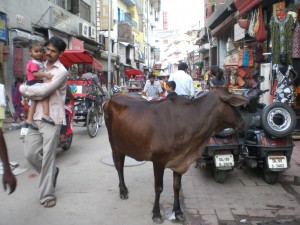
Cows, mopeds, rickshaws, people: all coexisting, and more common than you might think – Delhi, India
We stroll through this other side of town for the remainder of the afternoon. The snapshots, the sense of paparazzi continue. I am on the other side of the earth, so far removed from anything that was ever familiar. I can’t help but feel as though I’m on the most exotic and elaborate movie set ever constructed; except the players never break character, the director never yells, “Cut!” and the film just keeps rolling. There is no facade; India just surrounds me. Time, rarely kept here, passes by us.
As the sunlight wanes, we enlist a driver of a bicycle rickshaw who pedals a different route back to our hotel. The sights are horrifying.
What was whimsical and wild, suddenly becomes bleak. There are beggars everywhere, many of whom somehow survived the torturous clutches of the “beggar mafia” – now living with mutilations and deformities begging for pennies a day. As children, their severed limbs earned them more money than healthy kids. We were suddenly thrust into a real-life Slumdog Millionaire. One man in particular, looking haggard and beaten, chases after us in vain – not running, but crawling and knuckle-walking like an ape. What I thought could only be a film’s exaggeration was pure, evil truth.
This encounter couldn’t be shaken like a spider or a bad toilet. I would later discover that these atrocities inflicted upon children by doctors cost the mafia about $150 a child. Still to this day, I can’t say which feeling is stronger – my heartbreak and anguish for these lost children, or my hatred and anger toward these gangs and ‘doctors.’ Either way, I had to write.
Feeling the strain of carrying my backpack all over, sleeping on a thin mattress the night before, both of our bumpy rickshaw rides, and the accident, I realize I could use a massage. As if the universe hears me, on our continued walk through the stalls of brightly colored fabrics, open flames blackening street food, sparkly beaded slippers, and countless other wares I do not ever need, I spot a sign that reads Massage. I turn to Chloë, “I am so doing that.” We split up for an hour, and meet back at a new restaurant nearby.
Into the evening, it’s up to another rooftop terrace, where Chloë smokes a cigarette and I snap pictures. We cool off with a couple of beers. While the cook stirs up veggie chow mein and chicken curry, we engage in conversation with a man who is very happy. We know this because he tells us, “I am VERY HAPPY!” We’re happy for him. His name is Uchu and he hails from Nigeria, there with an Indian friend. We share that we’re from the United States. “Ah, America. They like women thin, yes?” We smile and confirm this notion. “Ah! In my country, we like women BIG!” We laugh, knowing it’s true. Where Ucho lives, thin is not sexy; it’s poverty. An amusing discussion about our cultural differences goes well into the night. Similarities, too. Ucho, we find out, is a musician, and is very happy because he just booked a gig in town. One, sadly, we will miss due to our early morning departure to Agra, to see the Taj Mahal.
As I lay in bed that night, I trace back all that had happened in the mere 24 hours since I arrived in the Subcontinent of Asia. I had adapted better and faster than I thought possible. Amused but not that surprised, I realize the most memorable parts of India have been my encounters with the locals and visitors from afar. I can barely recall the Red Fort, but I can tell you all about Ucho and our rickshaw car driver.





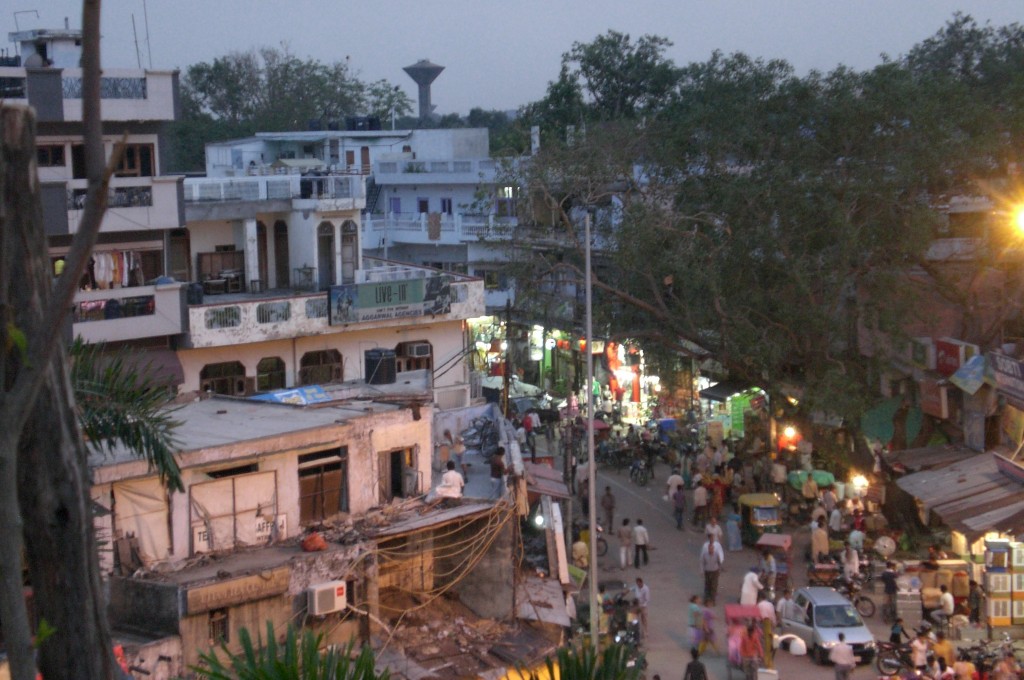
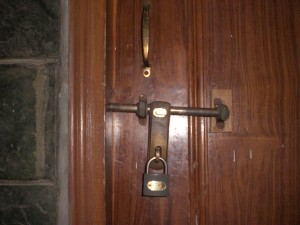
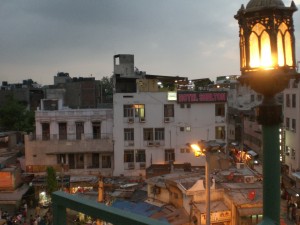

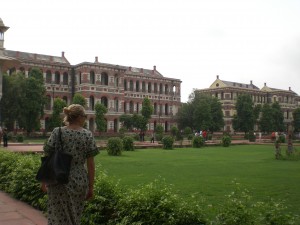
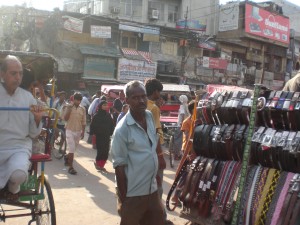

What a wonderful article. I felt as if I were transported to India without having to get the necessary “travel immunizations, aka SHOTS!”
Beautifully written. Looking forward to the next segment.